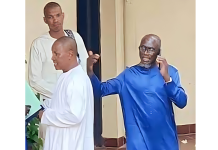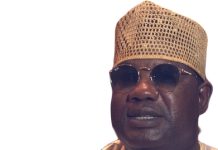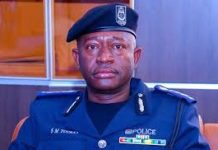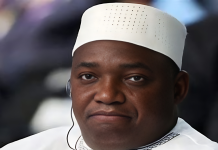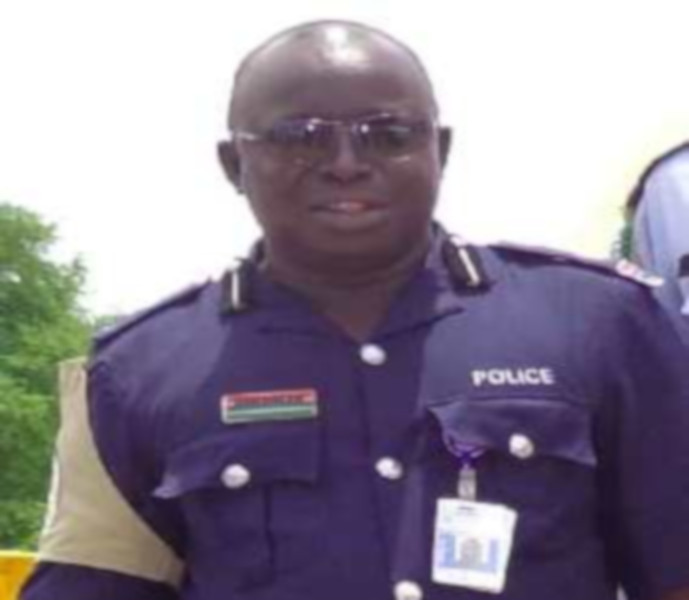By Yankuba Jallow and Mariama Marong
Sheikh Omar Jeng, an erstwhile deputy director of NIA responsible for operations has opened his defence in the NIA 9 case.
The NIA 9 Case involves 9 Intelligence operatives of the National Intelligence Agency (NIA) who are facing 25 criminal charges including the murder of UDP’s Ebrima Solo Sandeng.
Foroyaa brings you the verbatim testimony of Jeng while under examination by his lawyer, S. Kenedy.
What is your name?
My name is Sheikh Omar Jeng.
What is your address?
I live in Kanifing Housing Estate, F-Block number 14.
What is your occupation?
I am a security officer.
With which agency or institution?
The National Intelligence Agency.
What was your position?
Up to the time of my arrest, I was Assistant Director of NIA assigned to the portfolio to the directorate of operations.
When did you join the NIA?
I was recruited into the National Security Services – NSS as it was known then in October 1993. I did my basic training between January and April 1994.
Could you give us brief rundown of your career progression in the security service?
I graduated from the NSS training academy as the best and top of my class in 1994. Consequently, I was assigned to the analysis department and I was given the rank of Detective One. In 1995 July, after the military take over, and the service (NSS) was changed to the National Intelligence Agency, I was assigned to the Communication Department, which was the backbone of the service. In September 1995, I was deployed to the North Bank Division as the regional relation officer under the supervision of the Commissioner there in Kerewan. In September 1997, I was redeployed back to the headquarters in Banjul to the Communications Department again until August 1998, then I was deployed to Basse in URR as relation officer in Fatoto, Nyamanar and Sabi at various time.
In November 2000, I was redeployed back to the counter intelligence unit (CIU) as it called today. In September of 2001, I was deployed to Albreda and Juffreh as relations officer until September 2002. In September 2002, I was deployed to the Gambia Immigration Department as relations officer and a sitting member of the passport interview and issuance panel. During this period, I assisted the Immigration leadership in setting up two very important unit; the Immigration Enforcement Unit and the Immigration Investigation and Intelligence Unit.
Around April 2004, I was reassigned back to the headquarters to investigation department where I serve until December 2004.
In December 2004, I became part of the Gambia Government drive towards combating terrorism and consequently, I was released from all active office duties.
Between January 2005 and October 2009, I had no active engagement in the service. My assignment and activities were outside the shores of this county. Given the sensitive nature of what I did, I wouldn’t be at liberty to discuss those details in court. However, at the end of my assignment in 2010, I was reassigned to head the counter terrorism unit of the Agency (NIA) until June 2013.
In June 2013, I was deployed to the UN hybrid mission in Darfur, Sudan where I served until December 2015. In January 2016, I was appointed Assistant Director Operations, a position I served until my arrest in February 2017.
Between 1996 and 2017, alongside my various postings and assignment, I was a training instructor with the National Intelligence Agency Academy, I rose through the ranks to become the Commandant of the training school. Given that the training programmes were periodical, I continued with my normal duties until when training programmes were necessary.
As Assistant Director Operations what were your responsibilities?
The Agency had established a maiden unit called the monitoring and emergency room which was responsible for administering a triple 5 (555) toll free number and I was assigned to head that unit.
As at that time, there was no mainstream operations department in the Agency and the operations was under the purview of the deputy director general internal and external security who was the late Louis Leese Gomez of blessed memory – who was the second accused person in our current trial.
As administering and monitoring the emergency room, I was directly answerable to the deputy director general. My additional roles included assignments given to me by the deputy director general or the director general.
On the 14th April 2016, where were you on that day?
I was at work.
What time did you go to work?
14th of April was a Thursday, I got to the office around 6:45 am.
Can you tell us why you were at work that time?
Following my return from the mission in Darfur, I found an established tradition by the Agency that staff participate in a road running and physical exercise every Thursday starting 7 am.
Can you tell the court what you did on 14th April 2016 while at work?
At the end of the exercise, around 9 am, I went to my office to review the overnight reports from the monitoring and emergency room and from the department units that work overnight.
Following the reviewing of the various reports, I went ahead with my normal work until a little after midday when I had course to go into town.
Whilst inside Banjul, I received a call from the Monitoring and Emergency Room of the Agency informing me that someone had called to report a large and unusual gathering around the Westfield Cooperative Area. I then called the team leader of the patrol team around the Westfield Area and he told me that there was an ongoing protest by some people who made banners and using whistles, but he didn’t identify them at the time.
While speaking to him, the deputy director general Louise Richard Leese Gomez called me and summoned me to his office. As I was driving into the NIA headquarters, I received another call from the Director General Mr Yankuba Badjie asking about my whereabouts. I told him I was just driving in and he asked me to see the deputy director general.
When I reported to the deputy director general’s office, he asked me to find out what was happening around Westfield and I told him that I have already spoken to one of the patrol teams who reported to me that there was an ongoing protest by some unidentified people. While speaking to the deputy director general in his office, I got a call from the patrol team at Westfield Area reporting that the protesters were UDP supporters and that the Police Intervention Unit have just arrived to disperse them. He further reported that some of them refused to disperse and the Police Intervention Unit personnel…(before he could finish his statement, Lawyer Antouman AB Gaye for the State objected saying what he was saying was hearsay).
Lawyer S. Kenedy for Sheikh Omar Jeng submitted that what the witness was saying was direct evidence of facts and sequence. He referred the court to section 80 of the Evidence Act.
Justice Kumba Sillah-Camara overruled the objection because the witness was speaking directly to a member of the patrol team.
After receiving the information did you do anything? Asked Lawyer Kenedy
“Yes, my lady. I reported back to the deputy director general who couldn’t hear our conversation on phone as to the identity of the protest and that the PIU office were arresting those who were not compliant with the proclamation. He [the deputy director general] told me to keep monitoring the situation and I went back to my office to await further reports from the patrol team.”
Did you eventually receive further reports?
“Yes, my lady. The patrol team further reported.”
Who reported?
The team leader of the patrol team [whose] name I couldn’t recall because there were four patrol teams – each with shifts and each shift has a team leader.”
What was the report that you received?
“The team leader reported that those arrested were put at a police truck and some of those who ran away were pursued and arrested and harded on foot to the PIU headquarters. He further informed me that he saw the Inspector General of Police Yankuba Sonko, the then Minister of the Interior Ousman Sonko, the then Commander of Guards Battalion Sulayman Badjie and a good number of senior security officers from various security institutions have already arrived at the PIU headquarters. I communicated this information to deputy director general and he told me to brief the director general because he had taken some of his drugs, he was a little drowsy. I reported the same information to the director general.
He [Director General Badjie] said since all those service chiefs were at the PIU headquarters, it was appropriate that he also go there. Then we drove there with our separate vehicles.”
Do you know the time you arrived at the PIU headquarters?
“I cannot remember the exact time, but it was between 1 pm and 4 pm.”
Proceed.
“When we arrived at the PIU headquarters, the Minister of Interior Ousman Sonko, the Inspector General of Yankuba Sonko, the Commander of the Guards Battalion General Sulayman Badjie, the Commander of the Police Intervention Unit whom I believe was Commissioner Famara Jallow at the time, deputy superintendent Majic, but I don’t know his last name. He was the deputy to Famara Jallow at the PIU. There was a large presence of security officers within the PIU Complex, the PIU were present.
When you reached there, where were the arrested protesters?
“The arrested protesters were seated on the bare floor in a big hall inside the PIU headquarters.”
Do you know how many people were there in the hall?
“There were between 30 and 40. I saw a police officer going round with a container collecting their cell phones and other personal belongings.”
Do you recall if Solo Sandeng was part of those arrested?
Lawyer Antouman Gaye objected saying the question was leading. Lawyer Kenedy withdrew his question so that the case will continue.
Do you know any of the protesters that were arrested at the time?
“No, my lady, at that time, I couldn’t identify any of the protesters. However, I overheard the officials say the ring leader was one Solo Sandeng who ran away.”
Do you know whether he was eventually arrested?
“Yes, my lady. Whilst at the PIU headquarters, I saw a group of police officers numbering to about five came in with somebody who was later identified as Solo Sandeng wearing an unbuttonedshirt and sweating profusely.”
Did anything happen?
“Yes, my lady. The Director General Yankuba Badjie called me in the office where we sat with the other service chiefs and asked if I have my personal vehicle on the ground. He told me that the IG – Yankuba Sonko said he was instructed…….”
Before he completed his statement, Lawyer Antouman Gaye objected saying the evidence was hearsay and at this point, Lawyer Kenedy reframed his question.
What were the patrol vehicles to be used for?
“He [director general Badjie] said the police said they were constrained with vehicles.”
Lawyer Gaye stood up and objected again saying it was hearsay, but Lawyer Kenedy maintained that the evidence was direct and it cannot be considered as hearsay.
Justice Sillah-Camara ruled that the evidence came from a 3rd party and is thus, hearsay.
On continuation, Jeng said: “the director general told me that the vehicles were to be used to transport some of the protesters to the NIA headquarters and request of the Inspector General of Police.”
Lawyer Gaye stood up again and said “it is a tailor made evidence – we are objecting – it is hearsay.”
Lawyer S. Kenedy said the evidence was direct evidence of what the witness was told by his superior.
The trial judge overruled the objection saying the evidence was not hearsay.
Where the vehicles eventually made available?
“I provided three vehicles including my vehicle. I provided them three drivers. The Police Intervention Unit identified five of the detainees, put them on board the pickup and escorted them to the Banjul at the NIA headquarters. The five protesters I later came to know as Ebrima Solo Sandeng, Nogoi Njie, Kafu bayo, Ebrima Jabang and Modou Ngom.
The remaining protesters were also handcuffed and put on board the PIU trucks escorted by the PIU officers to the Mile 2 Central Prison.”
Did you also follow them to the NIA headquarters in Banjul?
“No, my lady. It was only the PIU officers and three of the drivers of the patrol vehicle who went with the protesters to Banjul.”
Did you eventually report back to the NIA on that day?
“Yes, my lady. I did. Immediately after they left, the security chiefs starting moving, but I waited with the patrol team waiting for our vehicles.”
What time did you get to the NIA?
I received a call from the Communication Unit that we all have to come back and be on standby. I got to the Office at around 6 pm.
Did you observe anything after getting to the NIA headquarters?
“Yes, my lady. At the entrance, I observed the normal security protocols. As I worked to my office, at the back of the storey building from the main gate, I encountered about five masked men struggling with a woman who was later identified as Nogoi Njie and as I approached them, the woman grabbed me and started pleading in Madinka Language saying “Mbaring Ke M’makoy” meaning ‘my brother please help me’. I found it difficult to breath because she grabbed me and held me tight [while] shouting “Mbaring Ke M’makoy”. Then I asked her what is the problem and she said “these people want to take me inside and I am scared. I couldn’t identify the mask men, but given previous incidents, my instinct told me they could members of the State House Patrol Team otherwise known as the Junglers. Then I said to the mask men, please release her let’s sit down and talk. When I started talking to her, two of the mask men came forward and one of them said “Sir Jeng should not fuck with us we will not let this nonsense from him.” They moved in and grabbed the woman and virtually dragged her, whilst I looked on helplessly.
“As I was coming out of the deputy director general’s office, I over heard screams coming from the Investigation Department Area which was not far from the administration area. I went there to enquire and found about five masked men again supposedly the same group I encountered in the earlier even though I couldn’t confirm. As I approached the room they were, one of them yelled at me and asked “what can I do for you?” And I said nothing. And before I withdrew from there, I saw some people whipping someone with what was like horse pipe. I went back to deputy director general’s office in fury and asked him, “Sir, what is happening there and he said to me in Wollof ‘ah! SOJ [referring to Sheikh Omar Jeng], this is what we have all seen together.” He [the deputy director general] further added in Wollof again “have you forgotten that your current boss – Yankuba Badjie was also dealt with by the same mask men who came here and beat him and left”.
I was dismayed.
What happened next?
I was dismayed after what I saw and the response I got from the people I look up to, given that I have just returned from serving the most reputable institution in this World – which is the United Nations where standards are upheld. I went to my office, spread my small mattress and lied down going over it until I slept.
What time did you eventually wake up?
I am not sure because I didn’t look at my watch. But given the sequence of events that happened afterwards, I will say it was around 4 am when the 8th accused person – Lamin Darboe knocked at my office door and woke me up. He [Darboe] was going round to check the lighting system and discovered what looked like a lifeless body lying outside the Investigation Department. He [referring to Darboe] told me in Mandinka “Sir, you are sleeping here when everybody has gone home.” I followed him to see what he discovered outside the Investigation Department. I went with him and discovered the lifeless body of who was later identified as Ebrima Solo Sandeng lying on the Bahamas grass just outside the investigation department. I have not known Solo before, but I recognised him from when he was heralded into the PIU headquarters by some police officers.
He [Solo Sandeng] wore only a pair of boxers and had no shirt. I bent down murmuring and called his name severally, but he didn’t respond. Instinctively, I took a scarf that was around my neck, placed it over his mouth and groom some air. I didn’t know what made me do that, but at that instant it was only CBR that came to my mind. However, what I discovered was when I groomed air into his mouth the response I got in return was a whizzing sound like when someone is under asthmatic attack.
I called the few officers including the security guards who were present.
Do you recall their names?
Yes, my lady. Lamin Darboe was one of them, Yusupha Jammeh was one of them, Yankuba Jallow was the driver for Yusupha, Sheikh Tijan Camara and Bara Gaye who were both prosecution witnesses in this case. I asked them to move the lifeless body into the guard room and place him under the fan. One of them discovered his clothes around the vicinity and they covered him with the clothes. I called the deputy director general, the late Louise Leese Richard Gomez and briefed him of what happned. He [referring to Louise] told me to call the director general because he was not feeling fine. I called the director general, Mr Yankuba Badjie – the 1st accused in this case and he instructed me to summon the medic – Lamin Lang Sanyang. I sent a vehicle to pick Lamin Lang Sanyang from his residence in Brikama. He arrived and examined the body. For the records, that was the first time I saw Lamin Lang Sanyang on that day. After his examination, Lamin Lang Sanyang told me that the vital signs of the lifeless body of Solo Sandeng were nil. He [referring to Sanyang] said Ebrima Solo Sandeng was dead.
I immediately stepped out and called the DG Yankuba Badjie and he asked if it was confirmed that he is dead. Sanyang and myself confirmed that indeed he was dead. The Director General asked me to hang up and that he will get back to me because he needed to brief his boss, the President. The President was Yahya Jammeh.
Did the 1st Accused get back to you?
Yes, my lady. The 1st accused got back to me and that he has reported to the President – his boss Yahya Jammeh and that Jammeh had specifically instructed that the body be buried.
Lawyer Antouman AB Gaye for the prosecution objected saying what Jeng stated was hearsay which came from a third party. Lawyer Sydney Kenedy maintained that the evidence was direct and not hearsay as contended by the prosecution lawyer.
The trial Judge ruled that the part of Jeng’s testimony concerning what the director general narrated about what the President told him was hearsay and inadmissible.
What was the instruction that you received?
The 1st accused instructed me to lead a team to bury the body on the order of the President.
At first I protested, by telling the DG that procedurally we should take the body to the mortuary which he acknowledged and asked that I give him time to consult with his boss – the President and get back to me. After few minutes he called me again and said “go ahead with the burial. It is an Executive Order.”
The prosecution lawyer also objected saying it is hearsay. Lawyer Kenedy argued the evidence cannot be regarded as hearsay because the witness narrated his conversation with his boss, the director general. At this point, Lawyer Gaye withdrew objection.
“Following the latest instruction, I mobilised the officers who were present who were made up of the patrol team and a few members of the Special Operations Team.”
Could you state the names of some of them?
Yes, my lady. Myself Sheikh Omar Jeng, Lamin Lang Sanyang, Yusupha Jammeh who was the 5th accused person in this trial, but was discharged, Dawda Ndour who was prosecution witness 1 in this trial, Sheikh Tijan Camara who was also a prosecution witness in this case, Yankuba Jallow, Leon Gomez and I am not sure, but I think Haruna Suso.
After you mobilised the team, what happened next?
We drove to the NIA Coastal Command Complex in Tanji which is a government facility and buried the late Solo Sandeng dead. After, I personally led a Janazah [funeral prayer] for him. We were between 14 and 20 and everybody who went with me on that down directly participated in the burial. Thereafter, I assigned one vehicle to return the medic to Brikama where he lived and I instructed the rest of the patrol team to go to their exchange points and hand over to the incoming shift because their shift was to end at 8 am. When we all dispersed, I went home to my family.
The case will be coming on the 11th January 2020.

